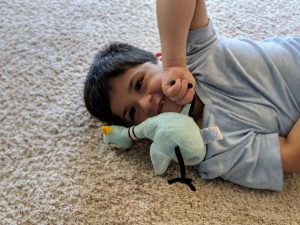 When we talk about reciprocal communication, we think about having a conversation when one person speaks, someone replies, then the initial speaker follows up. Harvard’s Center for the Developing Child refers to this as “Serve and Return”, and Dr. Stanley Greenspan coined the term “circles of communication”. These reciprocal interactions occur outside of verbal communication and start as early as infants cooing at their mothers, or reaching their arm out to touch their mother’s nose.
When we talk about reciprocal communication, we think about having a conversation when one person speaks, someone replies, then the initial speaker follows up. Harvard’s Center for the Developing Child refers to this as “Serve and Return”, and Dr. Stanley Greenspan coined the term “circles of communication”. These reciprocal interactions occur outside of verbal communication and start as early as infants cooing at their mothers, or reaching their arm out to touch their mother’s nose.
Although I’ve been focused on increasing Joey’s reciprocal communication, I haven’t tracked his specific participation in these “circles”. I have taken data on the purpose behind his communication, such as was he making a demand, responding to a question, making an observation, or exploring the vocabulary on his device. Although this gave me an interesting insight into Joey’s communication patterns, it did not specifically look at whether or not he was initiating the interactions, simply responding to a question, or stating a word or phrase that was not intended to be responded to by a conversation partner. After I realized that his communication had changed to being mostly responses in August as we prepared for school, I began to realize that I needed to also monitor how Joey participates with his conversation partners if I want to create meaningful change.
Joey’s initiations into communication are important because they show us his sense of agency. All children, but particularly children like Joey who have constraints around their independent motor movement, need to understand that they can interact with their environment – they do not simply need to wait for something to happen to them. This sense of agency is where children begin to develop their ideation – when they form their own ideas, opinions, and thoughts. Through identifying what they want and how to get it, they independently create multi-step plans, which supports the development of their executive functioning skills. This sense of agency is critical to development.
Although Joey does a wonderful job responding to my communication initiations, I want to see him initiating more. I want Joey to share his opinions, make plans, and purposefully tell silly jokes without being prompted. In short, I want Joey to be in charge of his communication.
In my first day of tracking, Joey’s patterns varied in both ten minute time samplings. For our first activity, Joey responded to nine of my requests, and initiated ten times. Six of his words came from exploring his device, when he was not intending to interact with me. During the second ten minute segment, Joey responded to me 11 times, but never initiated conversation. By this time he was getting tired, and seemed ready to explore words rather than discuss our activity. Seeing that Joey went ten straight minutes without initiating an interaction with me tells me that I need to increase my wait time, or build more activities where Joey feels inspired to initiate and make observations.


